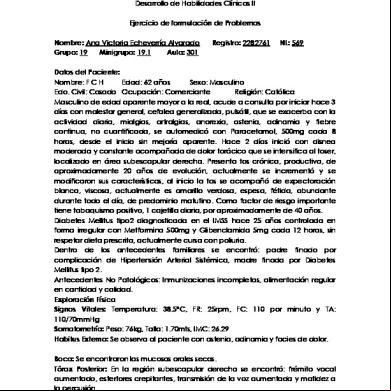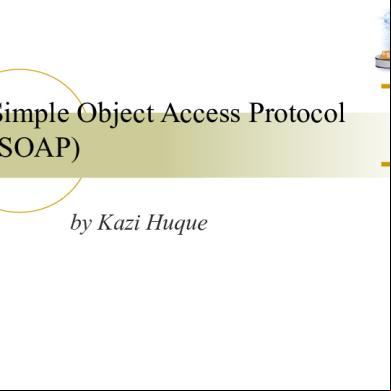Discussion Soap 7404y
This document was ed by and they confirmed that they have the permission to share it. If you are author or own the copyright of this book, please report to us by using this report form. Report l4457
Overview 6h3y3j
& View Discussion Soap as PDF for free.
More details h6z72
- Words: 890
- Pages: 4
DISCUSSION This experiment was carried out to prepare soap with using mineral oils and to investigate and compare the properties of soap and detergents. In saponification, the fatty acids carboxylate ions are formed in the presence of the base. These carboxylate ions are the conjugate bases of the fatty acids, and therefore, able to accept a proton when placed into water. These conjugate bases are able to accept protons from any source including water. A soap is the sodium or potassium salt of a long chain fatty acid. The fatty acid usually contains 12 to 18 carbon atoms. Solid soaps usually consist of sodium salts of fatty acids whereas liquid soaps usually are potassium salts of fatty acids. Soap such as the sodium stearate consists of polar end and non-polar end.
Figure: structure of sodium stearate When soap is use to clean a particular cloth the non-polar end which is hydrophobic or water-fearing part of the soap molecule can dissolve in the greasy or oil dirt while the polar end which is hydrophilic or water-loving part dissolve in water molecule. Therefore, dirt will be pulled away from the surface of the cloth and suspended in water. Thus soaps acts as an emulsifying agent, a substance used to disperse one liquid 9oil molecules) in the form of finely suspended particles or droplets in another liquid (water molecules). The cleansing action of soaps depends entirely upon the fact that they ionize readily in water. We can imagine what would happen if the ionic end lost its charge. When the ionic end of soap lost its charge, the soap would no longer be able to dissolve in water molecules and could no longer emulsify oil and dirt. This is what happens in hard or acidic water. Hard water contains metal cations, such as Ca 2+ and Mg2+ that react with the charged ends of the soaps to form insoluble salts.
Synthetic detergents were developed to overcome these limitations of soaps. Synthetic detergents are similar to soaps. Just like soap, synthetic detergent also possess and ionic end and a non-polar end. However, synthetic detergent differs from soaps in their structure which make them less susceptible to form insoluble Ca2+ and Mg2+ salts. Many detergents and a few soaps contain phosphates, which serve as bases to neutralize acidic water and also to form insoluble salts with the Ca2+ and Mg2+ ions. This method will prevent the soaps from forming the insoluble salts. However, soluble phosphate salts, like sodium phosphate will cause explosive growths of algae when discharged into lake or river. This situation will disrupt the aquatic ecosystem due to deoxygenating from the decomposition of dead algae. Due to this, phosphates have been outlawed to be used in detergents in many places.
The synthetic detergent that was used in this experiment ‘Dynamo’, the pH of soap solution obtained was 10 while the pH of synthetic detergent solution was determine to be 8. The 1st properties comparison was carried out by adding mineral oil to 3 solutions (distilled water, soap solution, synthetic detergent solution), after shaking each of the solutions for three to five minutes, we observed that there were no emulsification for the test tube containing the distilled water. On the other hand, both test tubes that contained soap and synthetic detergent solution showed an emulsification.
The 2nd comparison test was to test the properties of soap and detergent in hard water. 3 ions solution had been in this experiment (1% CaCl 2, 1% MgCl2, and 1% FeCl2). The observation that will be observed in this experiment was whether the solution will formed precipitate when we add the soap and synthetic detergent solution. From result, we can observe that the soap solution formed precipitate which appear as sticky scums with all of the solutions while the synthetic detergent did not formed any precipitate. When mineral oil was added into the corresponding solutions, we could observe that the synthetic detergent solution produced and emulsified mixture but the soap did not.
The 3rd comparison test was to check the behaviour of soap and synthetic detergent solution in acidic solution. A 1M HCl was inserted into the solution drop by drop until the pH = 3. For soap, the number of drops of acid added to the soap solution was 7. The soap did not emulsify the solution. For synthetic detergent solution, the number of drops added to the solution was only 2 and it emulsified the acidic solution.
The final comparison test between soap and synthetic detergent was to check the cleansing abilities of both solutions. From the result, we could observe that the synthetic detergent cleaned the cloth strip very well. Soap solution does not possess good cleaning abilities because the tomato sauce can still be seen on the cloth strip. Finally, we can conclude that the synthetic detergent was more effective to be used as cleaning agent than soap because of its higher abilities to remove tomato sauce from the cloth strip.
REFERENCES 1. Organic Chemistry (3rd edition), R. T. Morrison & R. N. Boyd, 1973, Allyn and Bacon, Boston.
2. Fundamentals of General, Organic and Biological Chemistry (3 rd edition), J. McMurry, M. E Castellior, 1999, Prentice Hall, Inc. Upper Saddle River, New Jersey.
3. Experiments in General Chemistry Featuring Measuring Net, Bobby Shanton, Lin Zhu, C. H. Atwood, 2005, Brooks/Cole Laboratory Series, USA.
Figure: structure of sodium stearate When soap is use to clean a particular cloth the non-polar end which is hydrophobic or water-fearing part of the soap molecule can dissolve in the greasy or oil dirt while the polar end which is hydrophilic or water-loving part dissolve in water molecule. Therefore, dirt will be pulled away from the surface of the cloth and suspended in water. Thus soaps acts as an emulsifying agent, a substance used to disperse one liquid 9oil molecules) in the form of finely suspended particles or droplets in another liquid (water molecules). The cleansing action of soaps depends entirely upon the fact that they ionize readily in water. We can imagine what would happen if the ionic end lost its charge. When the ionic end of soap lost its charge, the soap would no longer be able to dissolve in water molecules and could no longer emulsify oil and dirt. This is what happens in hard or acidic water. Hard water contains metal cations, such as Ca 2+ and Mg2+ that react with the charged ends of the soaps to form insoluble salts.
Synthetic detergents were developed to overcome these limitations of soaps. Synthetic detergents are similar to soaps. Just like soap, synthetic detergent also possess and ionic end and a non-polar end. However, synthetic detergent differs from soaps in their structure which make them less susceptible to form insoluble Ca2+ and Mg2+ salts. Many detergents and a few soaps contain phosphates, which serve as bases to neutralize acidic water and also to form insoluble salts with the Ca2+ and Mg2+ ions. This method will prevent the soaps from forming the insoluble salts. However, soluble phosphate salts, like sodium phosphate will cause explosive growths of algae when discharged into lake or river. This situation will disrupt the aquatic ecosystem due to deoxygenating from the decomposition of dead algae. Due to this, phosphates have been outlawed to be used in detergents in many places.
The synthetic detergent that was used in this experiment ‘Dynamo’, the pH of soap solution obtained was 10 while the pH of synthetic detergent solution was determine to be 8. The 1st properties comparison was carried out by adding mineral oil to 3 solutions (distilled water, soap solution, synthetic detergent solution), after shaking each of the solutions for three to five minutes, we observed that there were no emulsification for the test tube containing the distilled water. On the other hand, both test tubes that contained soap and synthetic detergent solution showed an emulsification.
The 2nd comparison test was to test the properties of soap and detergent in hard water. 3 ions solution had been in this experiment (1% CaCl 2, 1% MgCl2, and 1% FeCl2). The observation that will be observed in this experiment was whether the solution will formed precipitate when we add the soap and synthetic detergent solution. From result, we can observe that the soap solution formed precipitate which appear as sticky scums with all of the solutions while the synthetic detergent did not formed any precipitate. When mineral oil was added into the corresponding solutions, we could observe that the synthetic detergent solution produced and emulsified mixture but the soap did not.
The 3rd comparison test was to check the behaviour of soap and synthetic detergent solution in acidic solution. A 1M HCl was inserted into the solution drop by drop until the pH = 3. For soap, the number of drops of acid added to the soap solution was 7. The soap did not emulsify the solution. For synthetic detergent solution, the number of drops added to the solution was only 2 and it emulsified the acidic solution.
The final comparison test between soap and synthetic detergent was to check the cleansing abilities of both solutions. From the result, we could observe that the synthetic detergent cleaned the cloth strip very well. Soap solution does not possess good cleaning abilities because the tomato sauce can still be seen on the cloth strip. Finally, we can conclude that the synthetic detergent was more effective to be used as cleaning agent than soap because of its higher abilities to remove tomato sauce from the cloth strip.
REFERENCES 1. Organic Chemistry (3rd edition), R. T. Morrison & R. N. Boyd, 1973, Allyn and Bacon, Boston.
2. Fundamentals of General, Organic and Biological Chemistry (3 rd edition), J. McMurry, M. E Castellior, 1999, Prentice Hall, Inc. Upper Saddle River, New Jersey.
3. Experiments in General Chemistry Featuring Measuring Net, Bobby Shanton, Lin Zhu, C. H. Atwood, 2005, Brooks/Cole Laboratory Series, USA.





